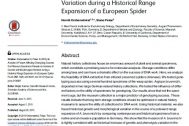Content
Natural history collections house an enormous amount of plant and animal specimens,
which constitute a promising source for molecular analyses. Storage conditions differ
among taxa and can have a dramatic effect on the success of DNA work. Here, we analyze
the feasibility of DNA extraction from ethanol preserved spiders (Araneae). We tested genotyping
success using several hundred specimens of the wasp spider, Argiope bruennichi,
deposited in two large German natural history collections. We tested the influence of different
factors on the utility of specimens for genotyping. Our results show that not the specimen’s
age, but the museum collection is a major predictor of genotyping success. These
results indicate that long term storage conditions should be optimized in natural history
museums to assure the utility of collections for DNA work. Using historical material, we also
traced historical genetic and morphological variation in the course of a poleward range
expansion of A. bruennichi by comparing contemporary and historical specimens from a
native and an invasive population in Germany. We show that the invasion of A. bruennichi
is tightly correlated with an historical increase of genetic and phenotypic variation in the
invasive population.



